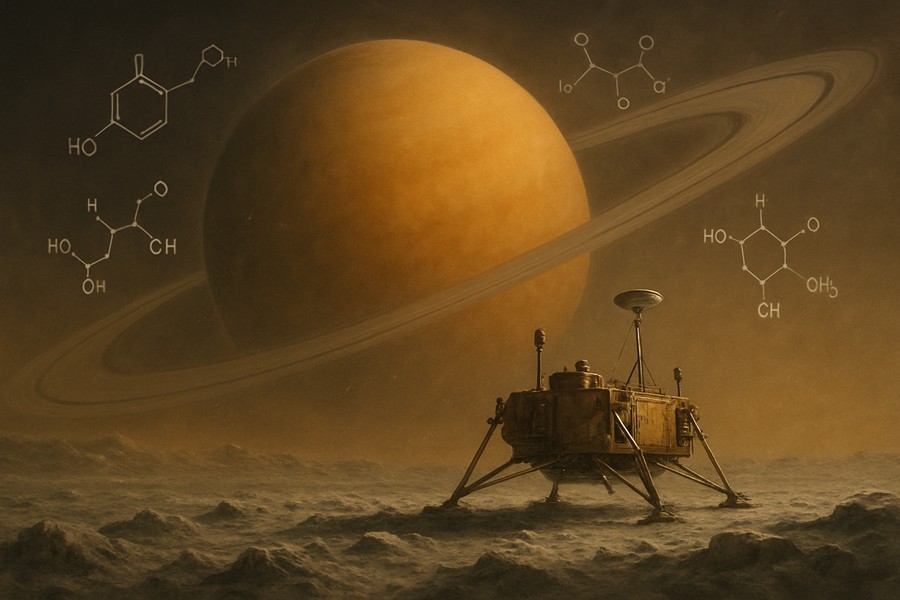
Groundbreaking Findings on Saturn's Largest Moon May Change Our Understanding of Pre-Life Chemistry
An intriguing revelation about the chemistry on Saturn's largest moon, Titan, has been made by a research team from a Swedish university and a United States space agency. This discovery, which defies fundamental chemistry rules, brings a fresh perspective to our understanding of Titan and the chemistry that existed before life began.
Mixing the Unmixable
Titan's extreme cold conditions allow for the combination of substances that typically would not mix. This breakthrough broadens our knowledge of pre-life chemistry. Titan, Saturn's biggest moon, holds a fascinating allure for scientists. Its evolution could offer valuable insights into the chemical processes that led to life. The moon's cold climate and thick atmosphere, rich in nitrogen and methane, mirror the conditions believed to have existed on Earth billions of years ago. Thus, studying Titan might provide clues to life's origins.
A leading researcher on Titan's chemistry has expressed optimism that the team's startling discovery – that polar and nonpolar substances can mix – will fuel further studies on Titan. He said, "These are very exciting findings that can help us understand something on a very large scale, a moon as big as the planet Mercury."
Uncovering Life's Building Blocks in Harsh Environments
The team's research paper reveals that methane, ethane, and hydrogen cyanide, which are abundant on Titan, can interact in ways previously thought impossible. The fact that hydrogen cyanide, a highly polar molecule, can form crystals with nonpolar substances like methane and ethane is a surprise. These substances typically remain separate, much like oil and water.
The unexpected interaction between these compounds could change our understanding of Titan's geology and its peculiar landscapes of lakes, seas, and sand dunes. Moreover, hydrogen cyanide could play a crucial role in the abiotic creation of life's building blocks. For instance, amino acids which are essential for protein construction, and nucleobases, necessary for the genetic code.
Collaboration with Space Agency Solves Mystery
The researchers were initially puzzled by what happens to the hydrogen cyanide created in Titan's atmosphere. They wondered whether it accumulates on the surface or reacts with its surroundings. To solve this mystery, a group from a California-based space agency started experiments. They mixed hydrogen cyanide with methane and ethane at temperatures as low as -180 degrees Celsius, which are conditions similar to Titan's.
Using laser spectroscopy to examine the mixtures, they found that the molecules remained intact, but something had happened. They reached out to the Swedish research group, experts in hydrogen cyanide chemistry, for insights. This collaboration led to ground-breaking research that questioned the basic chemistry rule 'like dissolves like', which suggests that polar and nonpolar substances should not mix.
Pushing the Boundaries of Chemistry
The researchers conducted large-scale computer simulations to organize the molecules in the solid state in thousands of different ways to seek answers. They found that hydrocarbons had infiltrated the hydrogen cyanide's crystal lattice, forming stable new structures known as co-crystals. These co-crystals can form in extremely low temperatures, like those on Titan.
The discovery challenges a fundamental rule of chemistry, but the lead researcher doesn't believe it's time to rewrite chemistry textbooks yet. He sees this as an exciting instance of boundaries being pushed in chemistry, demonstrating that universally accepted rules don't always hold.
A space probe named Dragonfly is planned to reach Titan in 2034, aiming to investigate the moon's surface. Meanwhile, the researchers plan to continue exploring hydrogen cyanide chemistry, in collaboration with the space agency. Hydrogen cyanide is prevalent in many places in the universe, including large dust clouds, planetary atmospheres, and comets. The findings of this study might help us understand what happens in other cold environments in space and whether other nonpolar molecules can also enter hydrogen cyanide crystals. This could have significant implications for the chemistry preceding the emergence of life.
